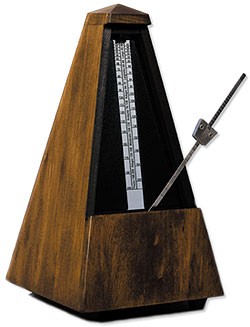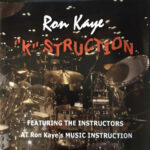
Myth #3 – Using a metronome is a waste of time and unnecessary to music lessons.
When discussing music and using a metronome, this particular myth is one of my favorites. As you will find, seemingly good arguments exist on both sides of the issue. However, the truth lies in understanding the purpose of the metronome. To begin, we need a little groundwork.
What is a metronome?
A metronome is a device which clicks or makes some sort of tone at regular measurable increments. For example you may set a metronome at 60BPM (Beats Per Minute) and it will click once every second. Earlier versions of the metronome utilized a pendulum device to adjust and keep time (click regularly) whereas, modern metronomes will utilize a digital type of sound and setting. You just set the BPM and hit start. The early design of the metronome was believed to be patented around the 1800’s. Musicians often utilize a metronome to help keep steady time or play music at a regular even interval, this often proves effective when working on odd meter. In theory, if music is written and assigned a tempo (speed) it is assumed that the reference is to metronomic timing.
All human beings have some sort of reference point for measuring “Time” or your inner clock. For most people, their frame of reference is their heart beat. Think about it. Even in the womb, we are exposed to a sense of timing – a pulse which is steady and even. To illustrate this point look at the facts. A person’s heart rate gradually slows as they age. Teenagers, for example, have a faster heart rate than someone in their fifties. Therefore, when it comes to music lessons, teenagers have a bit more difficulty playing steadily at a BPM like 50 or 60. Whereas, someone in their fifties would find it a little easier to play steadily at those slower tempos.
Other factors, as well, play a role in a persons ability to keep steady time. For example, if a young person is exposed to rapid stimuli such as a movie trailers flashing 1000 images a minute, their sense of time is going to be skewed faster. Another excelerator of a persons’s sense of time is music itself. Think about a diet of speed metal verses classical music. Which persons is going to have a harder time playing music at a slow tempo? Even stress can affect the way a person recognizes time in music. The more stress, the more your sense of time is stimulated, or sped up. What if you are one of those persons who absolutely has to have coffee to make it through the day? Does caffeine affect your inner timing ability? Absolutely. So you see, without learning to hear correct time in your mind as you play, or monitor your inner clock, the timing in your music can suffer. Hence, there is a legitimate place in music lessons for the use of a metronome.
So what is the controversy about using a metronome to learn music?

Some believe learning with a metronome restricts your creativity. Folks seem to either love the metronome or hate it. Practicing with a metronome has been criticized by some musicians as making your playing “Stiff” or “Mechanical.” If your playing becomes stiff as a result of using a metronome, it would be an unfortunate side effect of having not utilized the metronome properly.The idea of holding a sense of time to music performance is only one small aspect of what using a metronome accomplishes. However, the practice does not, necessarily, result in radical restriction in “Feel” or “Expression.” To illustrate the point, if you were to take a piece of written music and play it more “freely” and less rigid as the metronomic standard, the resulting music could be, and would be, written with entirely different notes, rests, etc. than the original. So the end result would be a different piece of music. Indeed, if a person taking piano lessons, for example, plays a piece “freely” each time they play, the standard of “Time” may vary each performance depending on the mood, energy level or caffeine intake of the musician. Since there is no enforceable or measurable standard every time they play, it could be different. Think of Mozart’s “Fur Elize” for example. How many ways have you heard that song “Stylized?” I would argue that removing a standard of time would be much like reverting back to Gregorian Chant or a arhythmic drum solos. While some folks may see beauty in this type of performance, the vast majority of people’s toes tap and their bodies respond to organized, measurable music. Think for a second about Rapp artists with no rhyme or use of syncopation yielding to a more “Free” approach. One of the main objectives in using a metronome is “Control.” Metronome critics seem to despise learning music with a metronome because of one of its’ chief attributes – control. Let’s face it, if you can’t control your playing, your musical performance will suffer. If a person learning to play the drums can’t maintain, let’s say, a swing feel while performing, the music will suffer, and it won’t swing. The swing genre relies heavily on maintaining a syncopated feel to its performance. If you cannot remain syncopated, or control the swing throughout the piece, it falls apart. Let’s face it, “if you can’t find The One your done!”
Therefore, control and a standard of timing is essential and does not, necessarily make your playing rigid, stiff, or mechanical. If this fallacy where true, why would almost every recording studio, from home studio to professional, utilize a click track or metronome as a recording quality aid? Why would electronic drum kits, electric keyboards, etc. come equipped with a metronome? There are metronomes of all types on the market today from the old pendulum type to apps on your smart phone. Now, if learning to play music with a metronome destroys creativity and feel, and metronomes have survived the test of time for hundreds of years (around the world), wouldn’t mankind have abandoned this loathsome practice long ago? Wouldn’t music have evolved away from this detriment to creative artists? The fact is there is no more of an effective tool for learning musical skills than the metronome. Learning to play music with a metronome does not make your playing stiff or mechanical unless you fail to understand how to use one.
Another misconception about the metronome and music lessons is that the practice makes students “Metronome Dependent.”
The prevailing thought is that when a person is taking music lessons, for example, they won’t be able to play music beautifully or in time without having a metronome or click track to assist their performance. This idea can become reality for some, if they are not taught to utilize the metronome properly. Using a metronome, as I said earlier, is an ear training exercise. The purpose for using a metronome is to be able to hear and recognize steady or even time. The practice is much like being able to learn to recognize the pitch of musical notes by hearing them played over and over. As much as a musician needs to recognize pitch in music, they have an equal need to recognize steady time. Most music has recognizable meter or time. In fact that is why 4/4 time is often referred to as “Common” time. The most common time signature of music is four over four, or four beats to a measure with the quarter note equalling one beat. Let me ask you, isn’t that a measurable standard of time? Anyway, once a student has the ability to recognize steady time by using a device such as a metronome, it is time to learn to play without the metronome. At this point the student has their senses tuned to recognize steady time, and they can play without the use of a metronome. Furthermore, once they can recognize where time is, they can begin to expand or free up their playing to add feel. A drum student, for example, who has a good grasp on steady time can begin to adjust one of the drum kit voices to be either slightly ahead or slightly behind the meter to aid the feel. A good example would be to slightly hold back the kick and snare to give the music a more “Bluesy” feel. Another appropriate use would be to play some voicing on the drum kit slightly ahead of the time to aid in creating a more “Energetic” feel. So the question becomes how can you slightly alter the time from steady and even if you can’t recognize where that is? The metronome is an “Ear Training” device. For great teaching and knowledgable instruction come see us at https://www.musiclessonspensacola.com .

